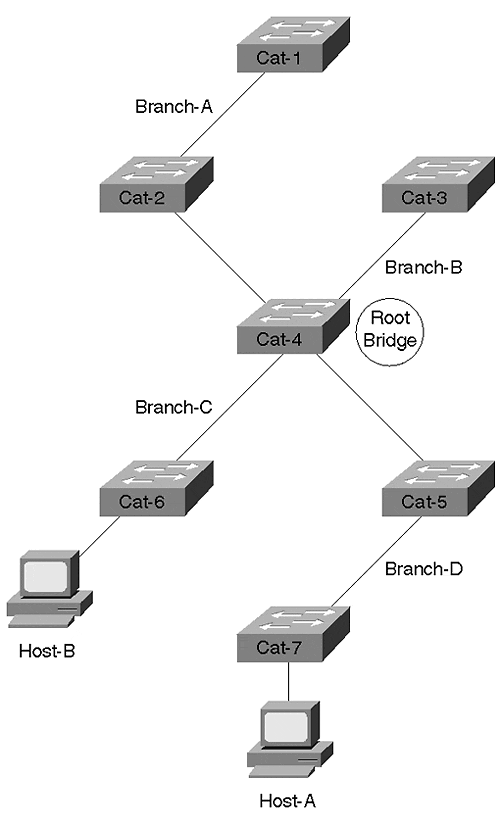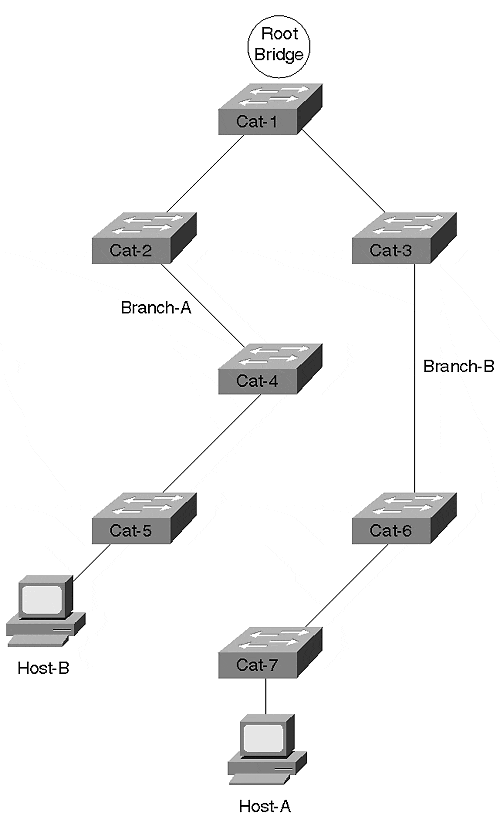Using Spanning Tree in Real-World Networks
Look at Figure 6-20 for a more complex topology, and see how all this STP detail adds up in the real world.
Figure 6-20. A Complex Network with All Links Shown

Figure 6-20 illustrates a network of seven switches connected in a highly redundant (that is, looped) configuration. Link costs are indicated all are Fast Ethernet (cost of 19) except for the vertical link on the far left that is 10BaseT (cost of 100).
Assuming that Cat-4 wins the Root War, Figure 6-21 shows the active topology that results.
Figure 6-21. Complex Network with Central Root Bridge and Active Topology

The setup in Figure 6-21 clearly illustrates the basic objective of the Spanning-Tree Protocol: make one bridge the center of the universe and then have all other bridges locate the shortest path to that location ("all roads lead to Rome"). This results in an active topology consisting of spoke-like branches that radiate out from the Root Bridge.
Notice that the Root Bridge is acting as the central switching station for all traffic between the four branches and must be capable of carrying this increased load. For example, Cat-7 and Cat-5 on Branch-D must send all traffic through the Root Bridge (Cat-4) to reach any of the other switches. In other words, don't use your slowest bridge in place of Cat-4!
Figure 6-21 also illustrates the importance of a centrally located Root Bridge. Consider the traffic between Host-A on Cat-7 and Host-B on Cat-6. When these two users want to fire up a game of Doom, the traffic must cross four bridges despite the fact that Cat-7 and Cat-6 are directly connected. Although this might seem inefficient at first, it could be much worse! For example, suppose Cat-1 happened to win the Root War as illustrated in Figure 6-22.
Figure 6-22. Complex Network with Inefficient Root Bridge and Active Topology

In this scenario, the network has converged into two branches with all traffic flowing through the Root Bridge. However, notice how suboptimal the flows are Doom traffic between Host-A and Host-B must now flow through all seven bridges!
In the event that I haven't convinced you to avoid a randomly chosen Root Bridge, let me point out that the deck is stacked against you. Assume that Cat-1 is a vintage Cisco MGS or AGS router doing software bridging (Layer 2 forwarding capacity equals about 10,000 packets per second) and the remaining six devices are Catalyst 5500 or 6000 switches (Layer 2 forwarding capacity equals millions of packets per second). Without even thinking, I can guarantee you that the MGS becomes the Root Bridge every time by default!
How can I be so sure? Well, what determines who wins the Root War? The lowest BID. And as you saw earlier, BIDs are composed of two subfields: Bridge Priority and a MAC address. Because all bridges default to a Bridge Priority of 32,768, the lowest MAC address becomes the Root Bridge by default. Catalysts use MAC addresses that begin with OUIs like 00-10-FF and 00-E0-F9 (for example, MAC address 00-10-FF-9F-85-00). All Cisco MGSs use Cisco's traditional OUI of 00-00-0C (for example, MAC address 00-00-0C-58-AF-C1). 00-00-0C is about as low an OUI as you can have there are only twelve numbers mathematically lower. Therefore, your MGS always has a lower MAC address than any Catalyst you could buy, and it always wins the Root War by default in a Cisco network (and almost any other network on the planet).
In other words, by ignoring Root Bridge placement, you can lower the throughput on your network by a factor of 1,000! Obviously, manually controlling your Root Bridge is critical to good Layer 2 performance.
EAN: N/A
Pages: 223